15 Office Organization Ideas to Keep Your Space Clutter-Free in 2025
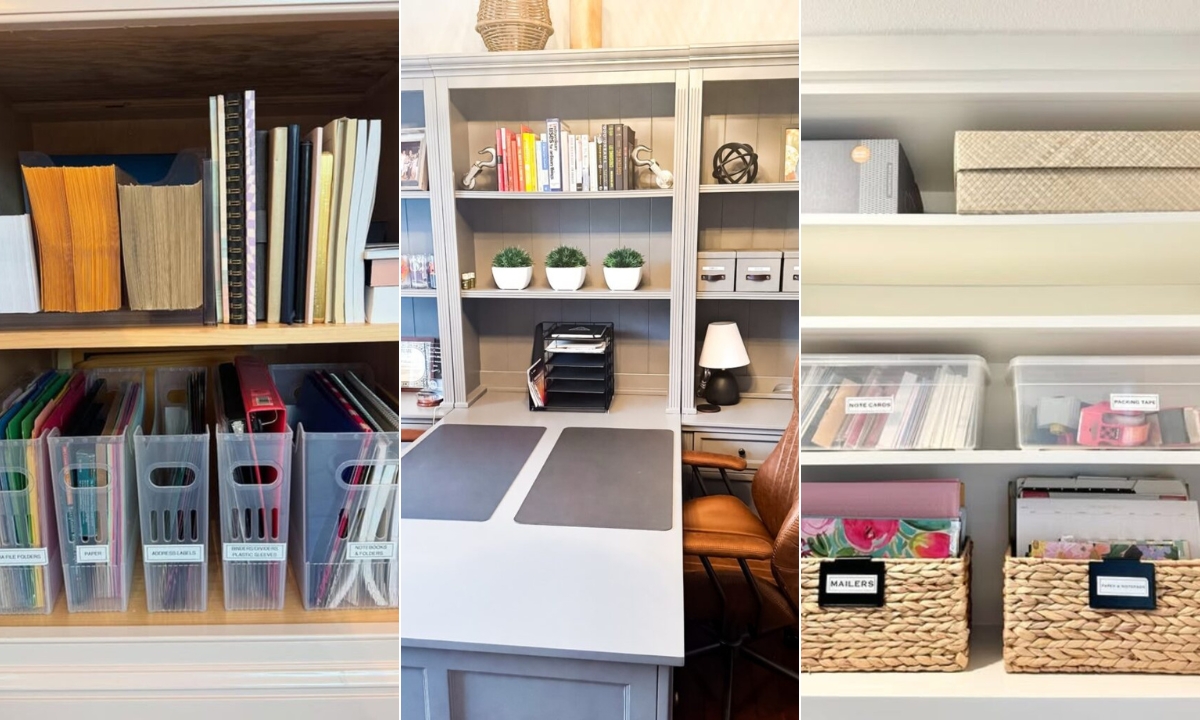
Every morning starts the same way. You sit at your desk, ready to dive into work, but the clutter pulls your attention in every direction.
A pile of papers stares at you, cords dangle like spaghetti under the desk, and your drawer is stuffed with things you forgot you even had.
It is not that you are messy on purpose-it just feels like the mess grows faster than you can handle. The issue is not you. The issue is the system around you.
If your workspace does not have a clear spot for everything, even a thorough clean-up only lasts a day or two before the chaos creeps back.
In this article, I will show you simple, practical solutions that actually work, whether you are in a home office, a small desk in your bedroom, or a corporate cubicle.
Let’s find out!
Contents
- 1 Why a Messy Office Kills Your Focus?
- 1.1 Label Every Basket
- 1.2 Divide the Desk for Two
- 1.3 Sort Papers in Clear Files
- 1.4 Use Vertical File Holders
- 1.5 Give Each Paper a Home
- 1.6 Turn a Closet Into a Supply Station
- 1.7 Categorize Files by Topic
- 1.8 Use Drawer Bins for Every Item
- 1.9 Store Tech Upright
- 1.10 Keep Drawers Clear With Grids
- 1.11 Label Every Drawer Section
- 1.12 Build a Grid Organizer Wall
- 1.13 Keep Shelves Minimal
- 1.14 Balance Decor With Storage
- 1.15 Stick to a Matching Set
- 2 FAQs
Why a Messy Office Kills Your Focus?
If your desk is full of papers, cables, and random supplies, your brain is already working overtime before you even begin your day.
Every item in your view fights for your attention, making it hard to focus. To work faster and think clearly, you need to remove the distractions around you.
Start with the surface of your desk, as it is what you see the most.
Take everything off, then only put back the essentials you use every day, like your laptop, a notepad, and one or two pens.
If you leave extra items out “just in case,” they will eventually turn into clutter again. When your desk is clean, your mind gets the same fresh start.
Save this article for later! 👇👇
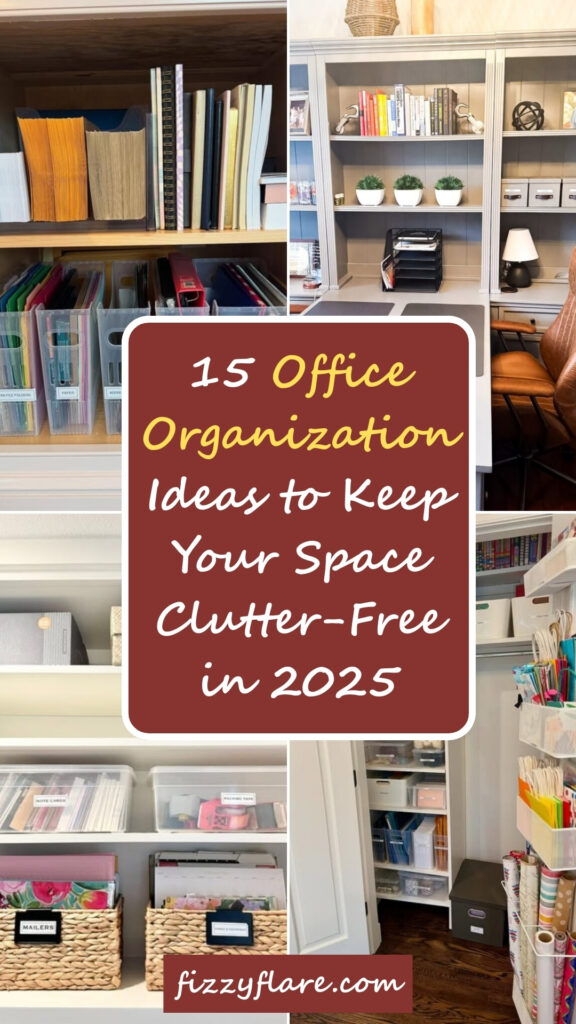
Label Every Basket
Open shelves become messy quickly when you do not give each item a specific place.
This setup works best in a closet-style office or supply cabinet where you store papers, stationery, and packing tools together.
To copy this system, use woven baskets for bigger items and clear bins for smaller supplies.
Put clear labels on the front so you always know where things belong. Spend five minutes once a week putting everything back in place to keep it organized.
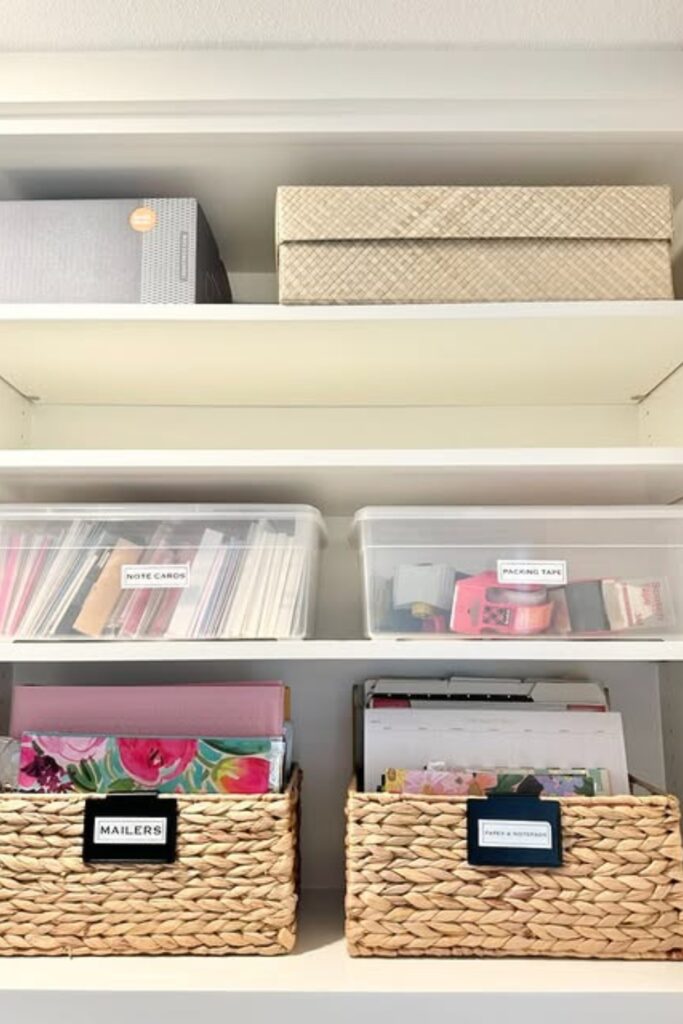
Divide the Desk for Two
Sharing a home office does not have to mean fighting for space.
This setup works best when two people need a professional spot in one room without their stuff getting mixed up.
To recreate it, put the desks back-to-back or side-by-side with a clear divider in the middle, like matching mats or trays.
Give each person their own shelves and storage boxes so your things never cross over. Add a few matching touches, like small plants, to make the space look put together.
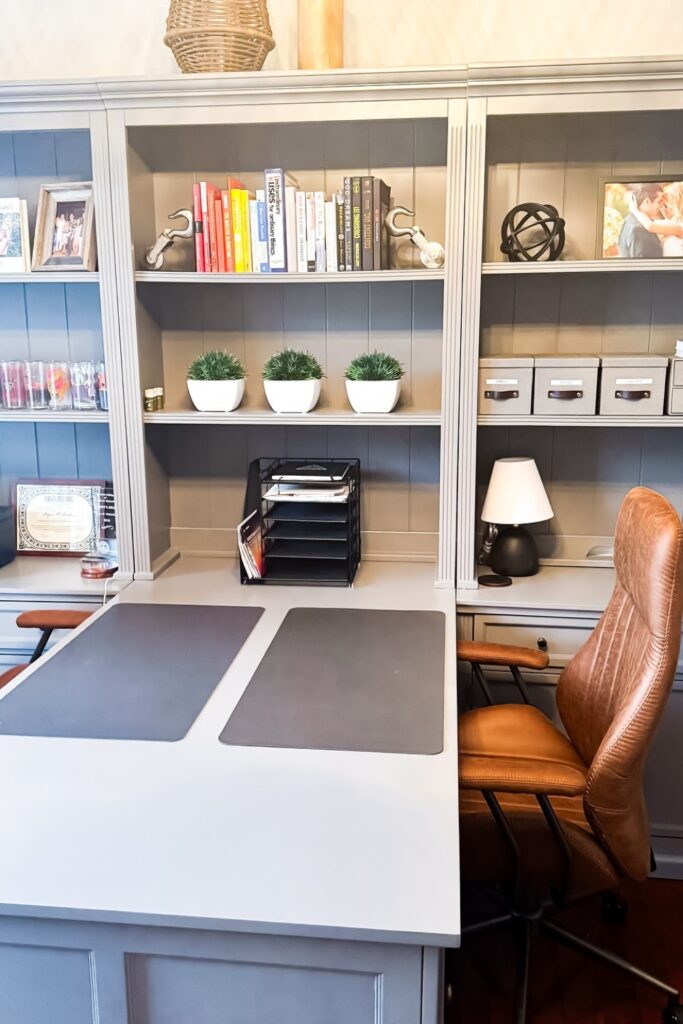
Sort Papers in Clear Files
Loose papers make it easy to lose important details. If you manage bills, projects, or client work, this setup will help you stay organized.
Use clear file boxes with labeled dividers so you can quickly find what you need. Assign one box for bills, another for projects, and a third for notebooks or journals.
Keep the boxes on a shelf within reach, and go through them once a month to get rid of outdated papers.
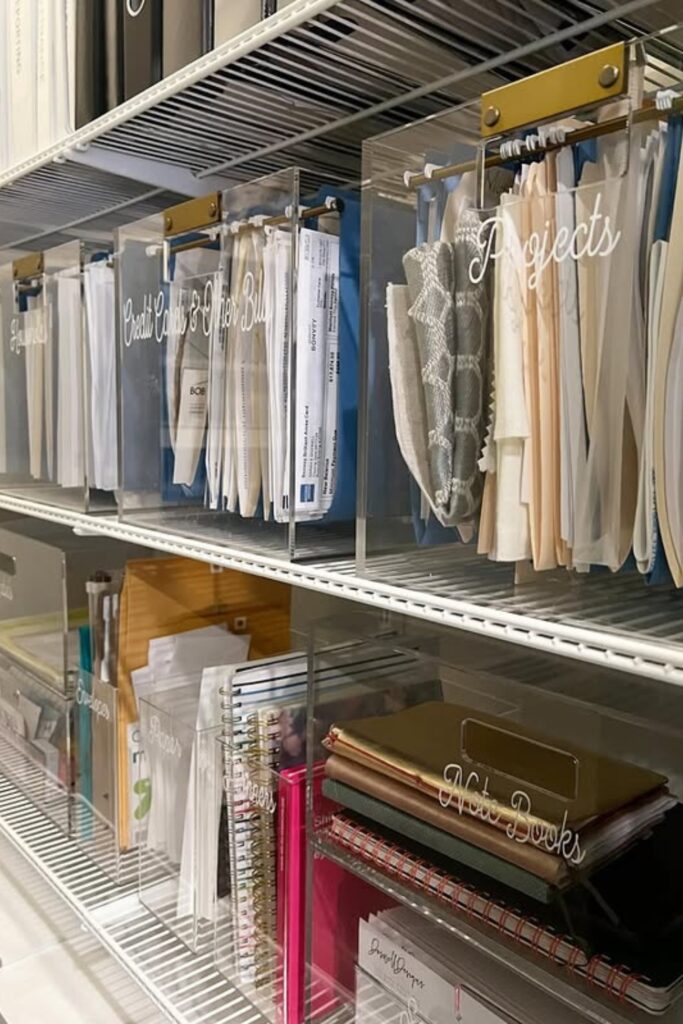
Use Vertical File Holders
Flat stacks of paper always turn into messy piles, but when you stand them up, you can grab what you need right away.
This trick works great inside a cabinet or bookshelf when you want quick access to folders, binders, and notebooks.
To make this happen, grab some labeled vertical file holders and give each one a job-like “Paper,” “Labels,” or “Notebooks.”
Stand your envelopes and journals upright on the top shelf to keep them tidy. Check on your bins once a month so they do not get too full.
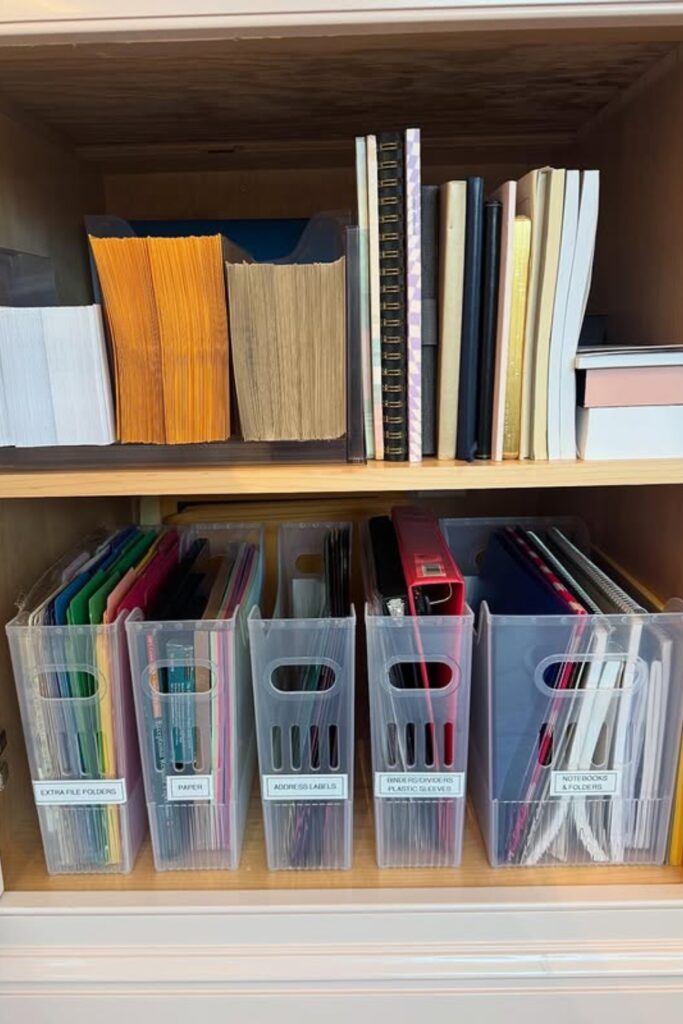
Give Each Paper a Home
Random stacks of mail and printer paper can quickly take over your office.
This setup works best in a cabinet or sideboard where you can hide the mess but still access everything easily.
To create this system, use divided trays to sort incoming mail and small bins to store supplies like notepads and pencil sharpeners.
Place larger mesh baskets at the bottom to hold printer paper and cardstock without bending them.
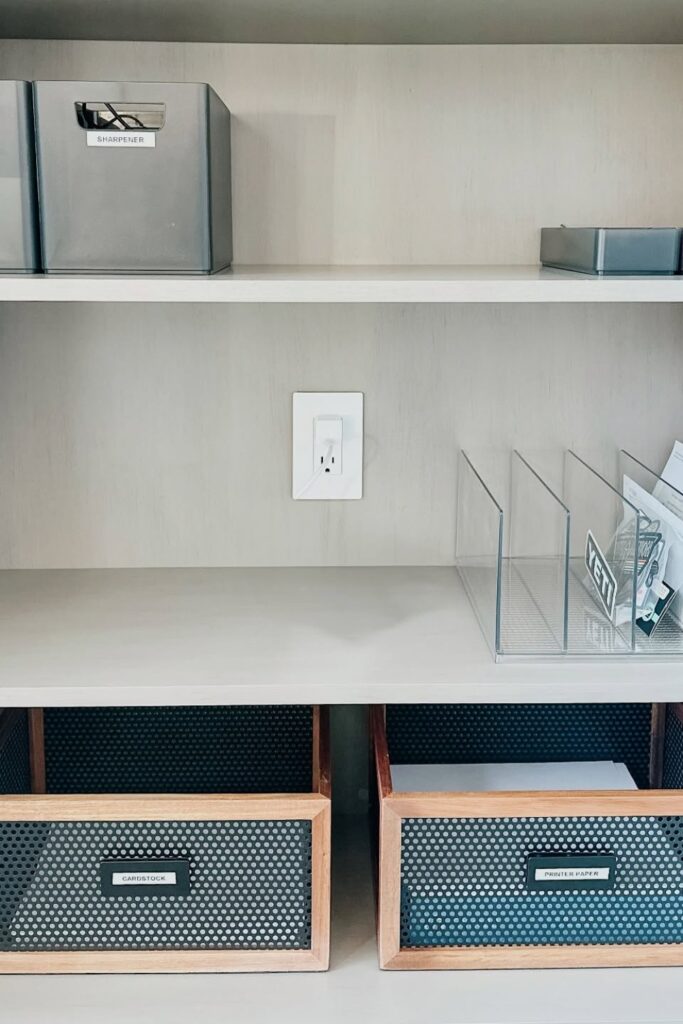
Turn a Closet Into a Supply Station
If your desk cannot handle all the extra stuff, turn a closet into a storage space to keep things organized and out of sight.
This works well for home offices that also store wrapping paper, craft supplies, or files.
To set it up, sort everything into labeled bins on shelves and use the back of the door for hanging organizers. Add a rack inside the door to hold wrapping paper rolls.
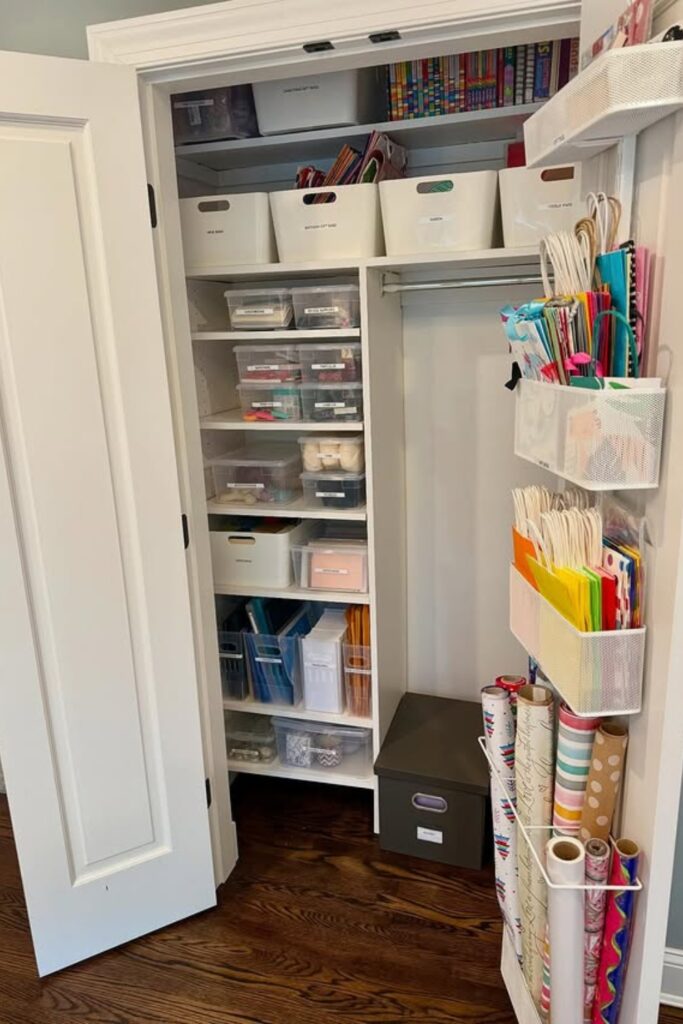
Categorize Files by Topic
When paperwork comes from different parts of your life, sorting it into clear categories helps you stay organized.
This method works well in a small home office or study with limited shelf space.
To set it up, use vertical file holders and label each one by topic, like “Medical,” “Expenses,” or “Projects.”
Line them up side by side so you can grab an entire section without digging through piles.
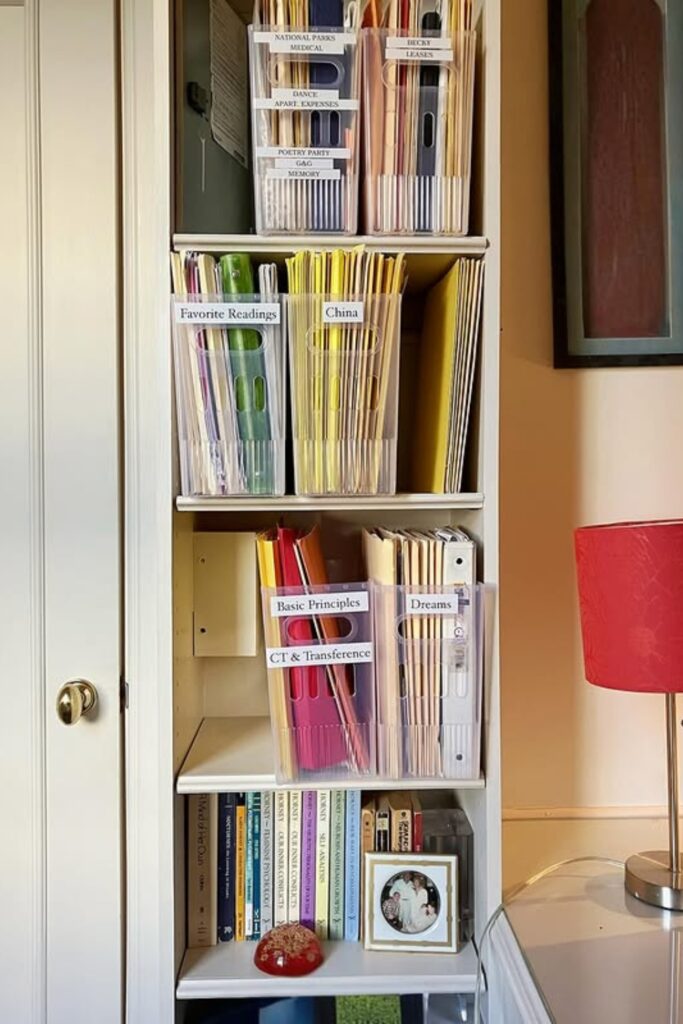
Use Drawer Bins for Every Item
A junk drawer becomes messy when items do not have a specific place.
This setup works best for office desks where you need quick access to pens, scissors, and small supplies.
To organize it, line the drawer with small bins and give each one a purpose-pens in one, notepads in another, and clips or chargers in smaller containers.
Stick to the rule of “one type of item per bin,” and spend a few minutes each week putting everything back where it belongs to keep the drawer tidy.
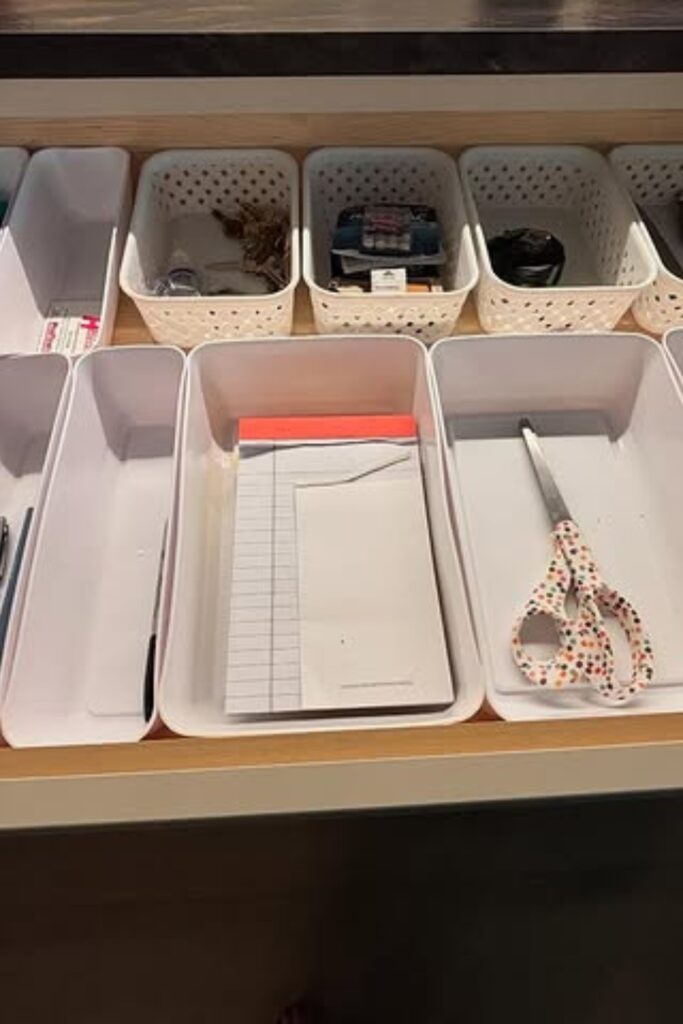
Store Tech Upright
Laptops and tablets eat up too much space when you stack them flat.
This method works best when you have several devices or shared family electronics that need to stay organized.
To copy it, place vertical file dividers or bookends on a shelf to store each device standing up. Put felt pads or soft dividers between them to stop scratches.
Keep chargers in a nearby drawer or labeled bin so everything goes together. Charging all devices once a week makes sure no device runs out of battery.
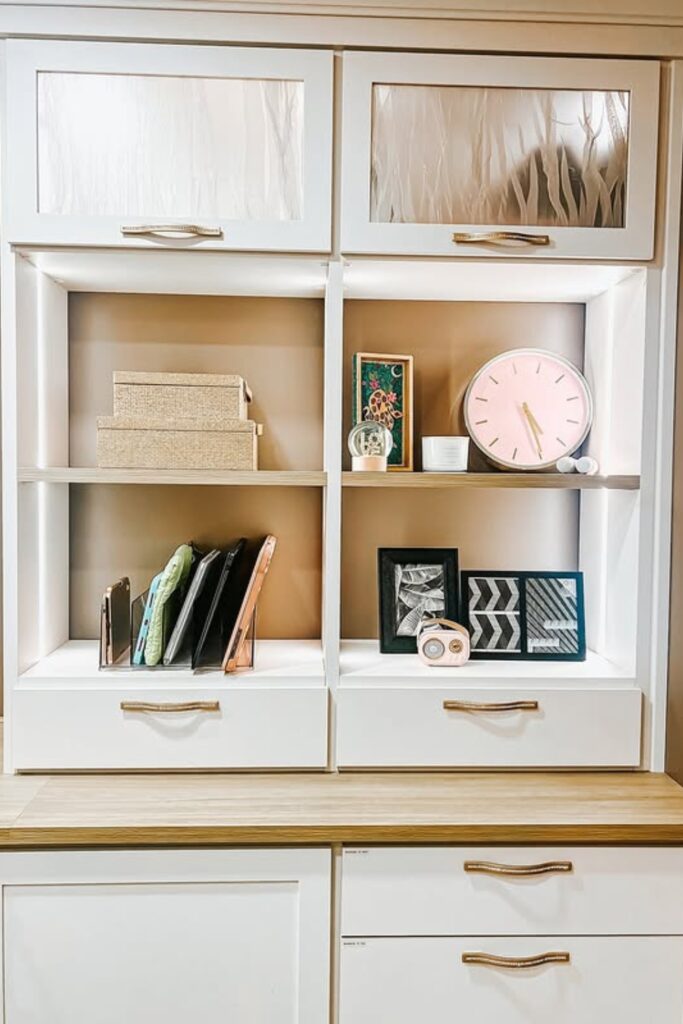
Keep Drawers Clear With Grids
A drawer only stays neat when every item has its own spot.
This setup works best for office supplies like pens, tape, and sticky notes that usually end up thrown together.
To make this work, get a clear grid organizer with separate sections.
Put similar items together-keep pens in one row, tape in another, and small things like paper clips or push pins in the smaller squares.
Follow the “one type per section” rule, and spend a few minutes each week putting everything back where it belongs to keep it organized.
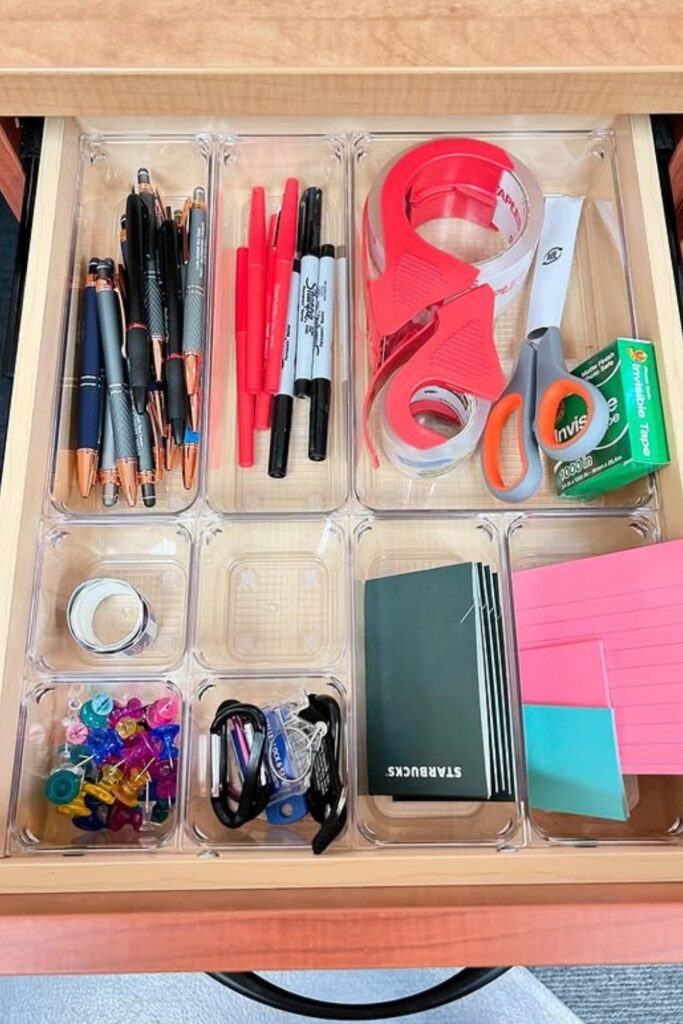
Label Every Drawer Section
When your drawers hold too many different items, labels stop everything from mixing together.
This system works great in a busy home office where you keep supplies, batteries, and daily tools in one spot.
To copy this idea, use clear containers to split up each item and stick a label strip on the front of the drawer.
Labels like “Pens,” “Batteries,” or “Tape” help you grab what you need right away. Check your drawer once a month to add more supplies and throw out broken items.
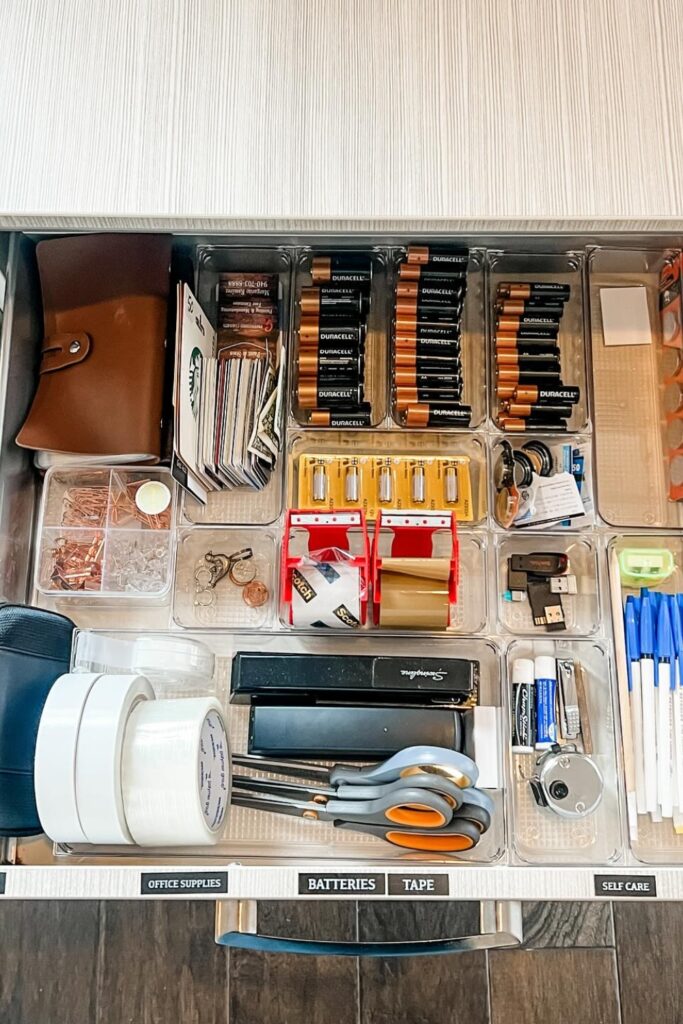
Build a Grid Organizer Wall
When you do not have enough shelves, a modular grid system can turn any closet into a storage wall.
This idea works best in home offices or craft rooms with lots of small supplies that often get lost in drawers.
To set it up, snap together wire cube grids and slide in clear bins or baskets for pens, paper, and tools.
Keep larger items like notebooks and boxes on the bottom to make it stable. Check your supplies once a week so you can restock before anything runs out.
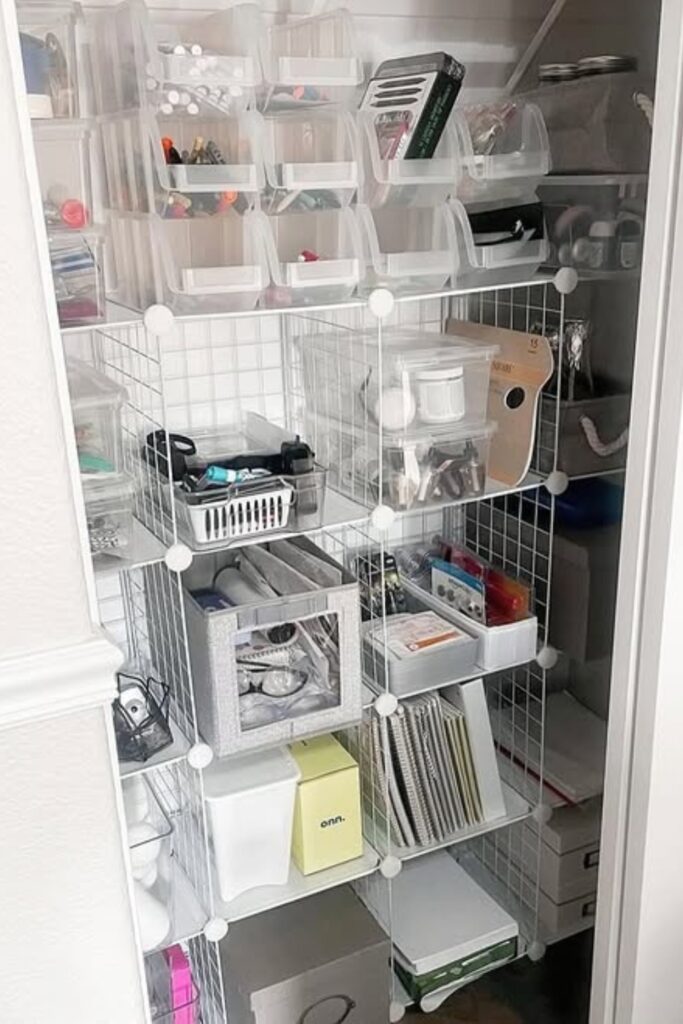
Keep Shelves Minimal
Sometimes the best way to organize is to keep things simple. This setup works well in modern home offices where you want a calm, clean look.
To copy this style, put only a few books or items on each shelf and space them out so the shelves look balanced.
Store bigger items in the closed cabinets below, and let the empty space make the room feel lighter.
Add soft LED strip lights to show off the shelves and keep your office looking neat.
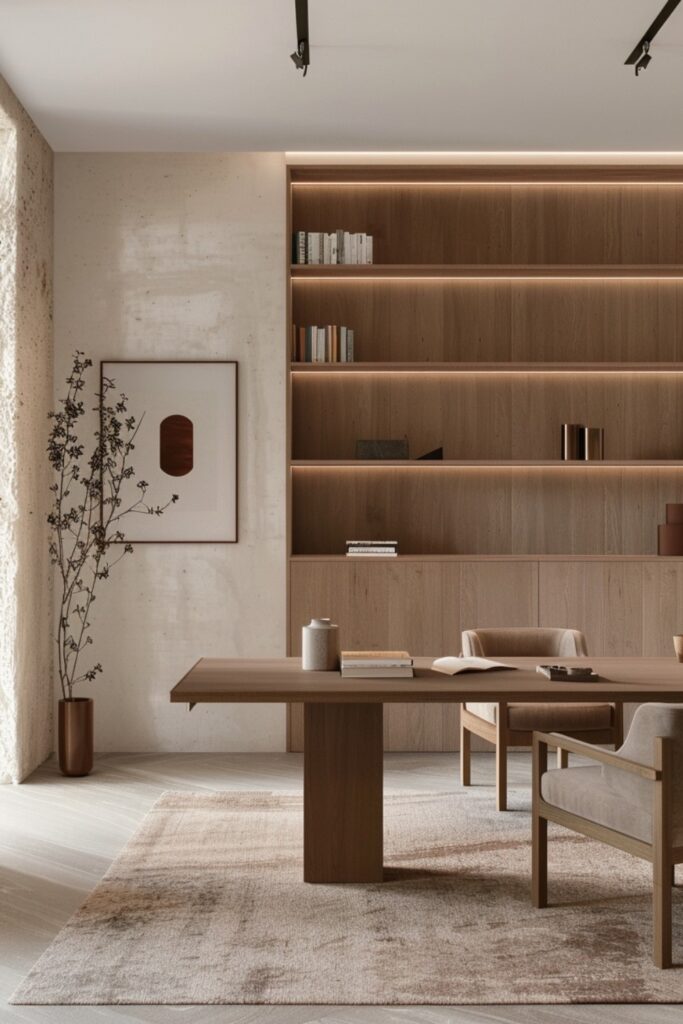
Balance Decor With Storage
A shelf full of personal items can easily look messy if you do not have built-in storage.
This setup works best in creative offices where you want to show off your personality without losing practicality.
To make it work, combine decorative pieces with closed boxes and labeled bins to keep essentials out of sight.
Place everyday items on the lower shelves so they are easy to grab, and use the top shelves for fun décor or artwork.
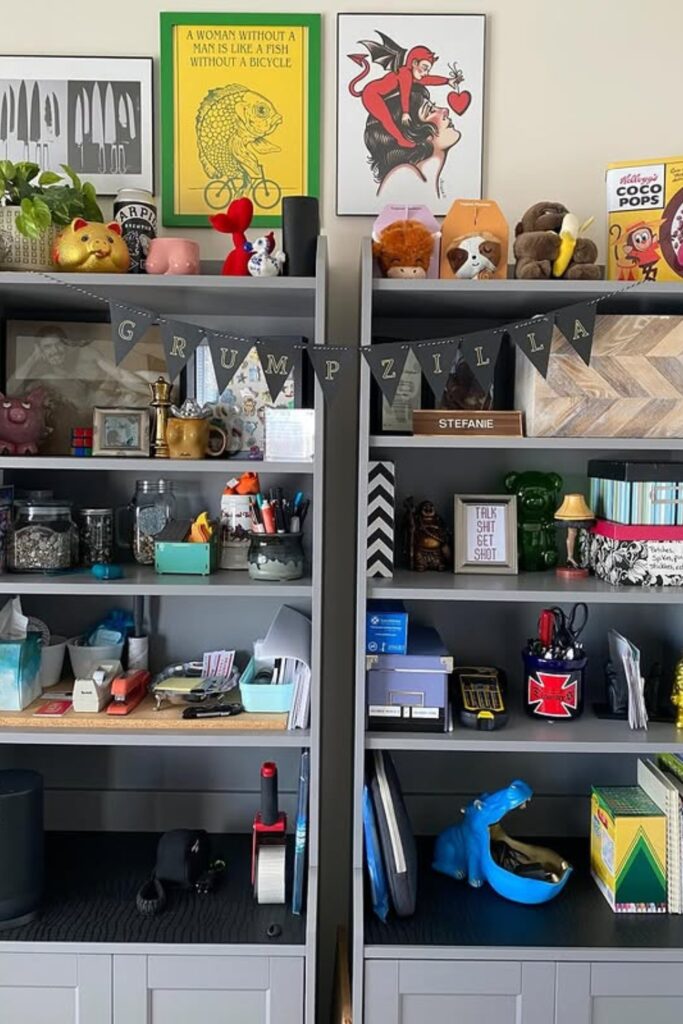
Stick to a Matching Set
Visual clutter can distract you just as much as piles of paper.
This setup works best if you want your office shelves to look neat and uniform while keeping paperwork out of sight.
To make it happen, use a full set of matching white boxes, file holders, and drawers with clear labels.
Give each container one job-like “Invoices,” “Notes,” and “File Folders”-so you always know what is inside.
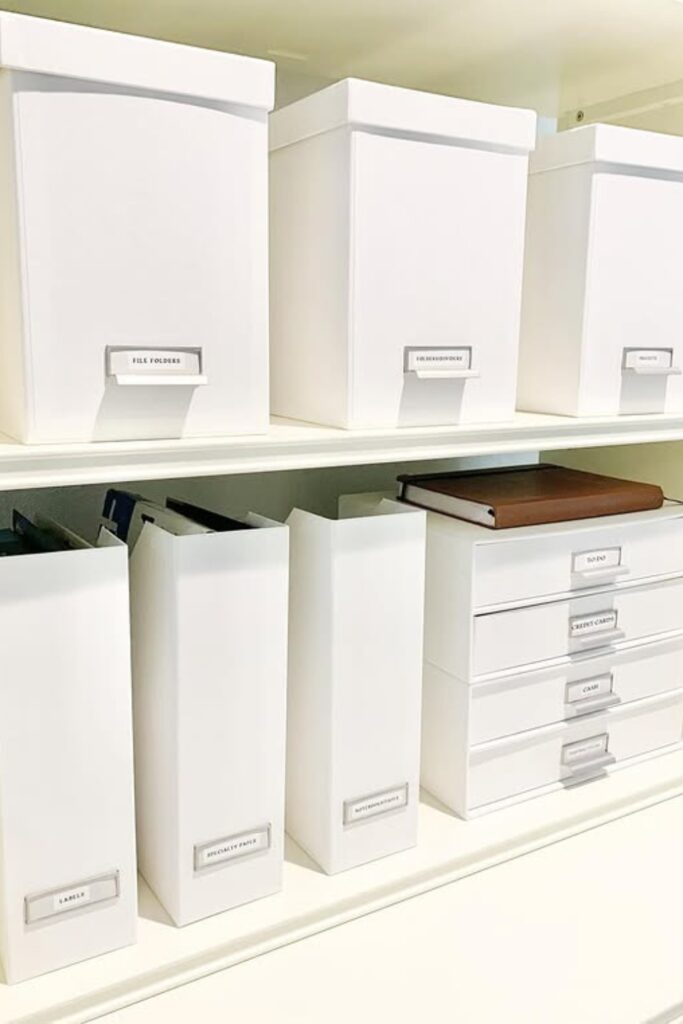
FAQs
How do I keep my office organized long-term?
The biggest mistake people make is believing that one big clean-up will solve everything. The truth is, you need a simple routine.
Spend five minutes at the end of each day clearing your desk and putting items back where they belong.
This small habit will keep your space under control. Once a week, take a few minutes to check your papers, throw away trash, and restock your supplies.
This way, your system will stay on track, and you will not need another big clean-up.
What’s the cheapest way to organize an office?
You do not need expensive organizers to keep things tidy.
Start with what you already have-shoeboxes, mason jars, and even kitchen containers are great for holding pens, cables, and papers.
If you want to take it a step further, stores like Dollar Tree or IKEA sell affordable bins and dividers that look good without costing much.
The most important step is to label every container so you always know where everything belongs, no matter how simple your setup is.
You may also like to read!
- 5 Hallway Organization Tips That Will Save Space in 2025
- 5 Entryway Hacks Professional Organizers Swear By
- 25 Bookshelf Organization Ideas for 2025

Fasial is the founder of the Fizzy Flare. He has been a passionate blogger since 2021. He ran three different websites in the past few years. Now he is focusing on Fizzy Flare to build an audience and help them organize their life.
